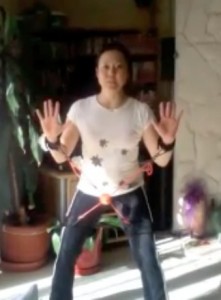Have you ever noticed that when you’re stressed out you start to experience neck or back pain? Or if you already have neck or back pain, the symptoms seem to intensify to intense and even intolerable levels?
One particular theory by Dr. John Sarno, author of “Healing Back Pain: The Mind-Body Connection,” proposes that what’s going on in your head can cause pain via increased tension in the nervous system. When nerves cause blood vessels to constrict, blood flow is decreased to the muscles, tendons, ligaments and nerves. The tension causes a buildup of metabolic wastes. The end result? More pain, spasm and tension. Hence, our already weak and injured areas often get the brunt of these effects when we get stressed out.
The great news is that there are effective solutions to get rid of this stress, and as a result, calm down your neck and/or back pain.
So I know you’re chomping on the bit to figure out what these are, so without further ado, here they are:
1. BREATHE. There is tons of research that show that deep breathing has the following benefits: relaxation, stress reduction, lowering of blood pressure, clarity of thinking, etc.
How to do it: Sit comfortably in a chair with your feet flat and your hands in your lap. Close your eyes and start to breathe deeply. Inhale for a count of six; pause for 2 seconds; and then exhale to a count of six; pause for 2 seconds. Do this for one minute. Check in to see if your pain has decreased. Keep going if this is effective.
2. FOAM ROLLING. This is a way of giving yourself a massage using a large rolling pin-like foam that’s 6 inches in diameter and 3 feet long. My clients all love it and marvel how amazingly effective it is for improving their posture, alignment
and eliminating pain.

How to do it: Lie length-wise on top of the foam roll so that your head and buttocks are fully supported. Open your arms out to the side to 90 degrees, allowing gravity to open up your chest and shoulders. Close your eyes and stay in this position for 60 seconds. This is instant nirvana and don’t be surprised if you fall asleep in this position (make sure to set a timer!).
3. ACUPRESSURE FOR THE EMOTIONS: This approach is also known as “Emotional Freedom Technique (EFT,)” or the “tapping” technique. EFT is surprisingly effective and works quickly. It entails saying positive affirmations whilst tapping on acupuncture meridians to clear the pathways from emotional blockages that may be causing back and/or neck pain.
Not only does this approach work for pain, but it can help you lose weight (imagine how the stress on your back will lessen), reduce food cravings (another way to lose weight), remove negative emotions and help you accomplish your goals.
You can get extensive and specific instructions here: http://bit.ly/d3VBh5 , but here’s a condensed version for you to implement now. If you’re in the Los Angeles area, you can contact Jonathan Boyd Barrett here: http://bit.ly/eIhFTK . He is an excellent practitioner of this method and I highly recommend him if you would like assistance with the technique. I will be doing an in-depth interview with him, so stay tuned!
How to do it: There are nine points you will be tapping, or stimulating the acupuncture meridians to clear the flow of energy. The first thing to know is the location of the tapping points.
1. Karate chop point: Side of hand.
2. Top of head.
3. Inner eyebrow.
4. Side of eye.
5. Under the eye.
6. Under the nose.
7. Chin.
8. Collarbone.
9. Under arm.
Now that you know where to tap, here’s how to implement the affirmations. The first step is to tap the karate chop point as you say three times, “Although I have back pain, I deeply and completely accept myself.”
Next, you will use one or two fingers to tap the other areas five to seven times while you say “back pain” once. You don’t have to be exact with the number of times you tap in each place, nor do you have to be super-precise with the acupressure point.
There you have it. Let me know how these worked for you. They seem very simple and basic, but they are extremely effective! Give it a go and I’d love to hear how you’re doing.
 I attended a spine seminar in Los Angeles several weeks ago. Alex McKechnie, the Sports Performance Coach for the Los Angeles Lakers, gave a lecture on how he performs core stabilization using a device he invented, the Core X.
I attended a spine seminar in Los Angeles several weeks ago. Alex McKechnie, the Sports Performance Coach for the Los Angeles Lakers, gave a lecture on how he performs core stabilization using a device he invented, the Core X.